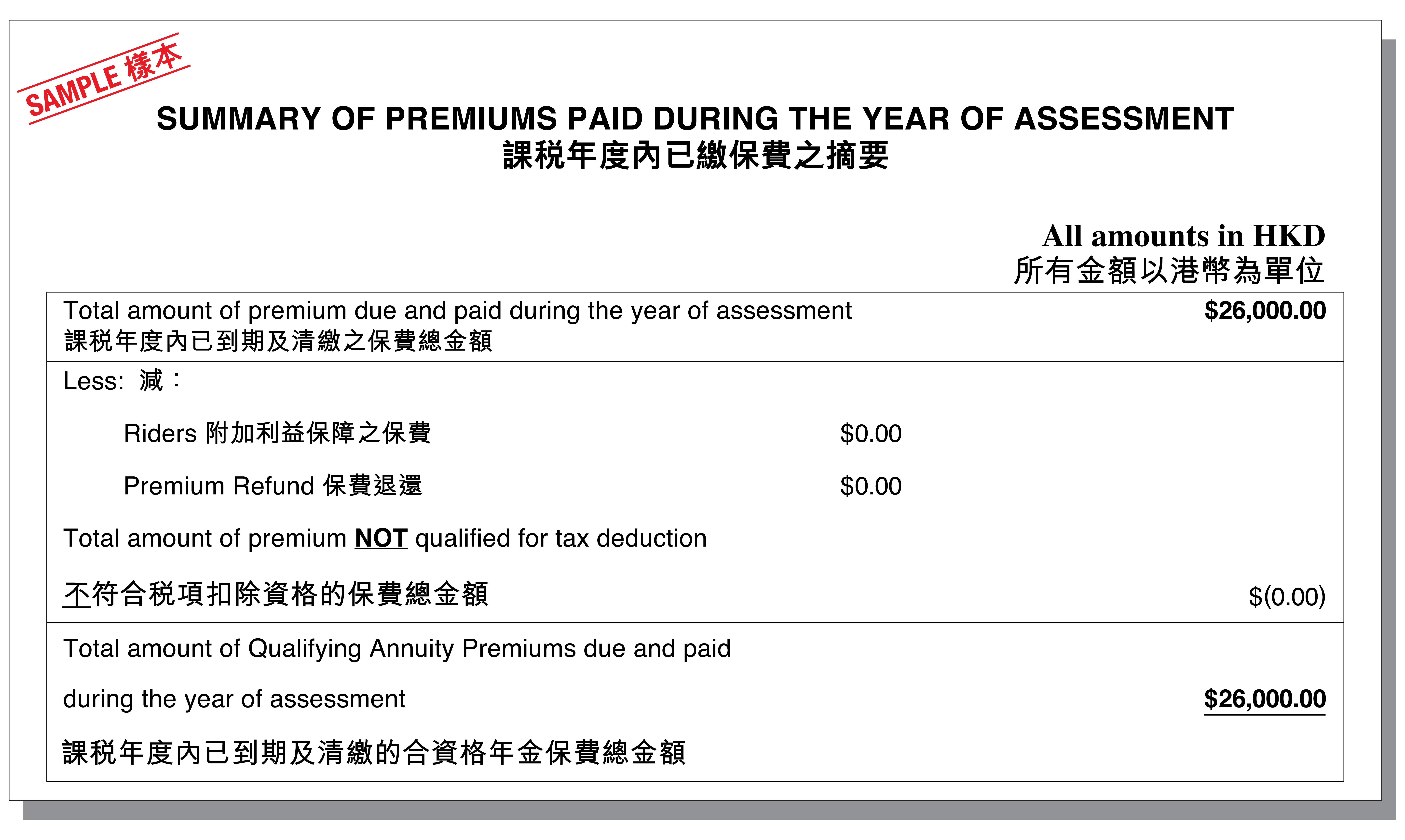A deft combination of payment and annuity options that empower you to enjoy your senior years on your terms
QDAP Tax Deduction Tutorial - now in session!
It’s the time of year to file your tax return! If you’re a taxpayer, have you purchased a Qualifying Deferred Annuity Plan (QDAP) during 2020-2021 to save for your retirement and enjoy the tax benefits? If you have, don’t forget to declare your QDAP contributions on your tax return form!
Before filling in your tax return form, make sure you have with you the relevant proof of QDAP premiums for the year from your insurance company or its copy, such as an annual summary of QDAP premiums as shown below.

Part 10 - Qualifying Deferred Annuity Premiums and Tax-deductible Voluntary Contributions (TVC). Item 2a of Part 10 is for the amount of the QDAP premiums that has been paid for yourself, while 2b is for the QDAP premiums paid for your spouse.

If you have paid QDAP premiums for yourself and/or your spouse, fill in the amount(s) in this part. There is no limit to the number of policies eligible for tax deduction, and each taxpayer is entitled to a maximum deduction amount of HKD60,000. A husband and wife who are both taxpayers can allocate their paid QDAP premiums among themselves in order to claim the maximum tax-deductible amount of HKD120,000, but the same amount cannot be claimed twice. As long as the two policies cover the husband or the wife or both of them as annuitants, and the deduction claimed by each of them does not exceed the individual limit of HKD60,000, the couple can claim a total of HKD120,0002 in tax deduction. Keep in mind, though, that HKD60,000 is the aggregate tax-deductible amount for both QDAP premiums and TVC contributions.
Individuals (with more than one QDAP policies)3
Peter has bought two QDAP policies for himself, with annual premiums of HKD50,000 and HKD20,000 respectively. The combined tax-deductible amount from his two policies is thus HKD70,000, exceeding the limit of HKD60,000 per person. Even if he fills in HKD70,000 in Part 10 2a, he will still only be eligible for a maximum of HKD60,000 in tax deduction.
Couples2 (two taxpayers)
Joseph and his wife are both taxpayers and have bought two QDAP policies for themselves. The annual premium Joseph is paying is HKD90,000 while his wife pays HKD30,000 a year. Joseph can apply for tax deduction on HKD60,000 of the HKD90,000 premium he pays. As the wife has not yet used up the deduction limit after claiming deduction for her HKD30,000 premium, she can also claim the HKD30,000 remaining from her husband’s premium. That way, both of them can apply for HKD60,000 in tax deduction, for a combined total of HKD120,000.
Couples2 (with a single taxpayer)
Andrew is a taxpayer. He’s bought two QDAP policies, one for himself and one for his wife, each with an annual premium of HKD60,000. Since his wife is not working and therefore does not have a taxable income, she is not eligible for any tax exemption for her QDAP premiums. The couple can’t file for a joint tax assessment, nor can they each file an individual tax return. That is why Andrew, as the sole taxpayer, is entitled to the individual limit of HKD60,000 in tax deduction and not the combined maximum of HKD120,000.
Tax deduction on both QDAP premiums and TVC contributions4
Jamie is paying HKD50,000 in QDAP premiums and HKD20,000 in TVC contributions each year. Since TVC contributions will be firstly allowed in the order of deduction, she is entitled to a tax-deductible amount of HKD20,000, and the remaining HKD40,000 will be allowed for deduction from her QDAP premiums. The maximum deduction Jamie can claim is thus HKD60,000.
Though you don’t have to include your annual QDAP summary with your completed tax return form, you should keep it for 6 years for possible selected reviews by the Inland Revenue Department.
The government introduced a trio of tax-saving schemes. In addition to the tax-deductible QDAP and TVC, a certified VHIS policy will also entitle you to tax benefits. If you haven’t bought any of these, maybe it’s time to start planning for the future and make full use of the tax concessions available.
Source:
- https://www.gov.hk/en/residents/taxes/salaries/allowances/deductions/annuity.htm
- Tax Deductions – FAQs regarding QDAP premiums and MPF VC contributions https://www.ifec.org.hk/web/common/pdf/qdap-tvc/FAQ_eng.pdf
- Number of Qualifying Deferred Annuity Policies https://www.ird.gov.hk/eng/faq/annuity_qp.htm
- Deduction order for qualifying annuity premiums and TVC contributions https://www.ird.gov.hk/eng/faq/annuity_qp.htm
Special offers
Apply for HSBC Income Goal Deferred Annuity Plan to enjoy up to a total of 17.5% off the annualised premium over the first 5 years.
Note: Discount of premiums is not tax deductible.
Offer ends 31 March 2026. T&Cs apply.
Disclaimer
The information contained in this article is for general reference only and is not intended to constitute a recommendation or advice to any person or to be the basis for any financial decision. No person should act on any information in the article without seeking professional advice.
The information contained in this article does not constitute an offer for the purchase or sale of any banking or insurance products or services. Products and services are subject to individual needs. Contact your financial planner to review your financial needs and risk acceptance level.
This article should not be reproduced or further distributed to any person or entity, whether in whole or in part, for any purpose.
HSBC Life (International) Limited (“HSBC Life”) has based this article on information obtained from sources it believes to be reliable, but which it has not independently verified. HSBC Life or The Hongkong and Shanghai Banking Corporation Limited (“HSBC”) makes no guarantees, representations or warranties and accepts no responsibility or liability as to its accuracy or completeness. Information in this article is subject to change without notice.
HSBC Life is authorised and regulated by the Insurance Authority to carry on long-term insurance business in the Hong Kong SAR. HSBC Life is incorporated in Bermuda with limited liability, and is one of the HSBC Group’s insurance underwriting subsidiaries. Insurance products provided by HSBC Life are only intended for sale through HSBC in the Hong Kong SAR. Policyholders are subject to credit risk of HSBC Life. For monetary disputes arising between HSBC and you out of the selling process or processing of the related transaction, HSBC will enter into a Financial Dispute Resolution Scheme process with you; however any dispute over the contractual terms of the product should be resolved between HSBC Life and you directly. For details and information about HSBC Life products, please visit the insurance-related pages at HSBC’s website or visit our branch.
All the information in the article is updated as of June 2021.
Issued by HSBC Life (International) Limited (Incorporated in Bermuda with limited liability)
Date








